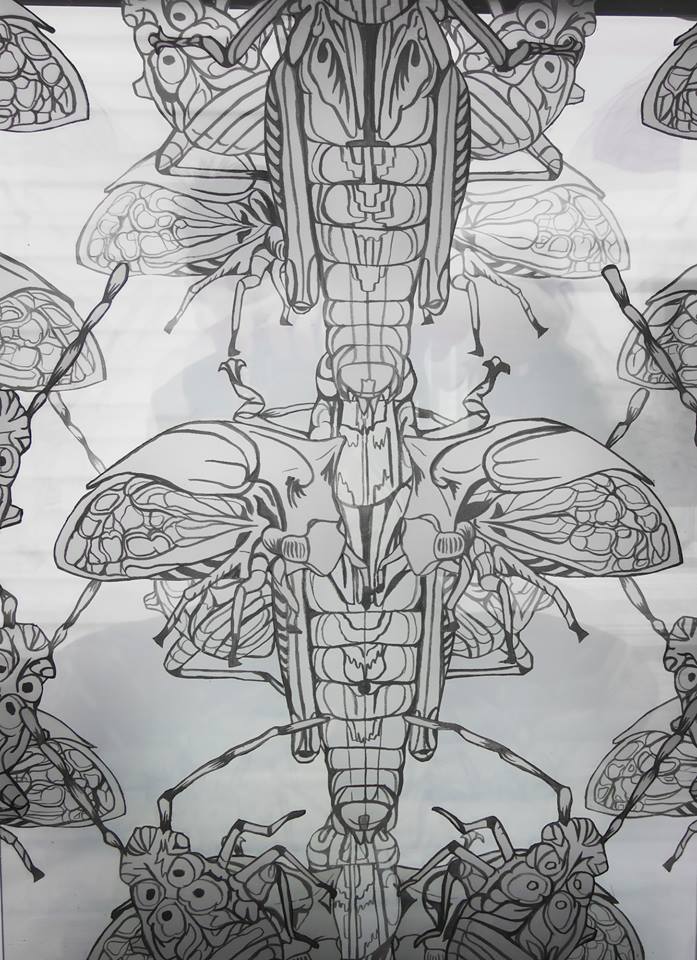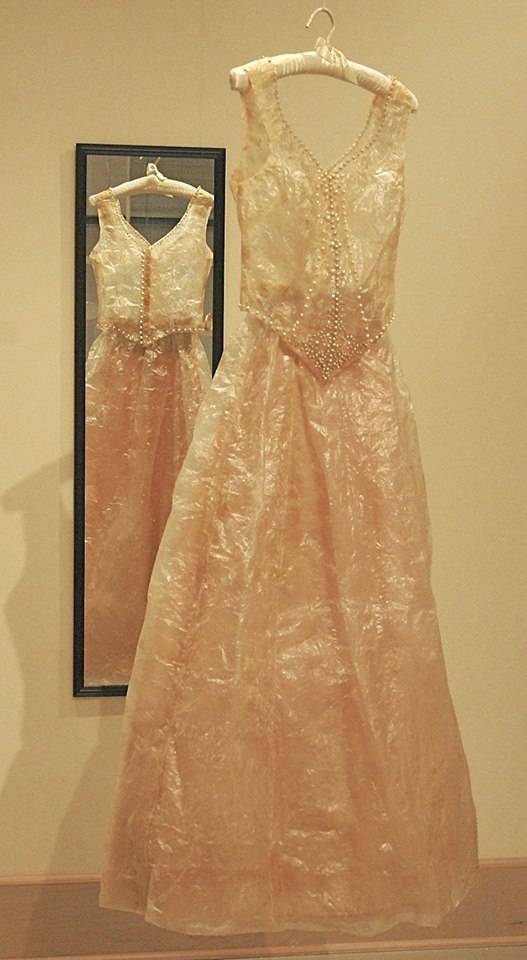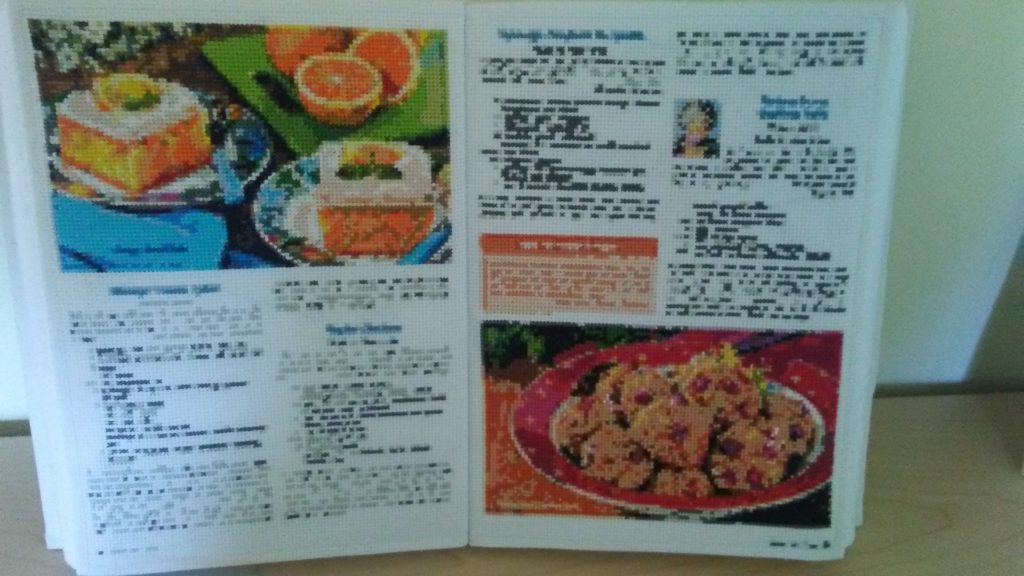Indigo Poirier explores the labour intensive, textile based work of Atlantic women artists, currently on display at STU’s Yellow Box Gallery.
Indigo Poirier

Kim Vose Jones’s artist statement states that she is, “attracted to the idea of a permeable quiet becoming part of the work I create, engaging with blurry zones where beauty, pain, terror, and joy coexist,” and this focus is clear even in her curatorial work with the Art of Labour, showing at the Yellow Box Gallery on STU campus until November 30th. The space in which the exhibition is situated (on the third floor of the Margaret Norrie McCain Hall on STU campus, inside a study hall—where making sound is actively discouraged) encourages the viewer to quietly contemplate the art and its meaning from a variety of angles. The pieces contained within—all created using textiles, all created by women—deal with different aspects of femininity and the relationship between the natural and artificial in a way that invokes a wide and complex set of emotions.
It should be said that my background is primarily in music, so I am not familiar with the techniques and concepts that go into making textile-based art. I’ve only recently begun to experiment with this medium. Even so, standing in this space, I can feel the tangible amount of time, patience, dedication, skill, and thoughtfulness that has gone into creating these works.
The fact that all the artists featured are women is not a coincidence. In her opening statement, Jones says, “In truth, I have always wanted to fill a gallery with the work of women. The voices of women. To give space, to take up space.”
I sat down for conversations with Kim Vose Jones as well as Danielle Hogan and Carol Collicutt, two artists who contributed works to the exhibition. We spoke about their work, the ways in which misogyny pervades the art world, and what it means to them to participate in an exhibition showcasing such powerful works created by women.
Danielle Hogan contributed a series of beaded masks (a small section of a much larger series she began in grad school) for her piece, Quantities Are Limited. In her artist statement she talks about the concept of Femaffect, which are complex feelings that can arise for women and LGBTQ+ people resulting from the use of textiles in their practice. While these feelings don’t always have to be negative, she explains, the fact that they often are reflects the patriarchal society in which we live. In Kim Vose Jones’s opening remarks, she states, “Danielle’s meticulously beaded masks, which are decorated with tassels, crosses and flowers all pointing to ways in which women have been represented, and essentialized. Danielle’s work however, refuses to give us an easy comfortable answer to a complex dynamic. These objects have elements of both empowerment and oppression tangled up together.”
In our conversation, Danielle told me that she wanted to explore working with objects that were valuable to her but only for a short period of time before they’re thrown away.
“And so I thought, I’m going to put a lot of visible labour- and for that body of work, it meant stitches,” she said. “I wanted to sew each of those little seed beads on by hand, bead by bead by bead, and you could see the time that it took to do it.

A wedding dress meticulously made out of gut and pearls. Photo: YBG Facebook
“I feel a fascinating and complicated pull to works that I can tell someone put a lot of time into, even if I don’t want to have them or am not aesthetically drawn to them,” said Hogan. “I find that how we quantify labour and how we decide what is valuable is such an important and complicated process that we all have to go through for ourselves.”
We talked about the concept of Femaffect and the ways that feminine labour is often devalued, both within the art world and without. A recent article by Canadian Art Magazine states that, despite women being just as well-educated and trained in the arts as men are, their average income is lower than those of their male peers. Though the study it referred to didn’t account for other factors like race, sexuality, age, whether the person was transgender or cisgender, etc., it points to a troubling trend across all mediums of women’s work not being valued as much as that of men.
As a musician who is also a woman, I’m familiar with the misogyny and systemic discrimination that exists within the music scene. I was under the impression, though, that the fine arts world was more refined and educated, and thus would be more committed to gender equality.
“I hate to disillusion you,” said Carol Collicutt, “but it’s not. There’s still the old guy painter thing, hanging in the background. There’s a lot of respect given to guy painters. They are lauded, they get shows, they’re painting in a tradition and it’s not even as if they’re breaking any new ground- they don’t have to. But then the women artists are the ones that are making interesting work, and I think half the time, it’s a blend of the women’s work that we’re all used to. There are people around the world who take that to another level, and that’s what women are doing, even with something as old-fashioned as embroidery.”
Carol’s piece, I Do, is a meticulously crafted wedding dress made from animal gut. The tension between such a beautiful subject—one that has long been a symbol of purity, devotion, and submissiveness—and such a raw, taboo, gruesome material was very much intentional. From her artist statement: “I need not explain the iconography of a wedding dress with all the weight it carries; what it means both historically and symbolically, and the perception of belonging it conveys. The expectations internalized by women about body image, perfection, and acceptance, influence choices to conform to false, unattainable ideals of beauty which are promoted by the fashion, cosmetics, movie and TV industries. This body of work as a whole exposes the pressure on women to try to achieve these ideals, sometimes with drastic medical procedures, the development of eating disorders, and the feelings of low self-esteem and false comparisons that are a result of this pressure.”
Kim also loves this piece, which was created in 2009, and asked Carol if she could include it in this exhibition. “I love works that set up this sort of intense tension between something that you want to touch but is also very repelling because you don’t want to break it,” she said.
“I really don’t like this culture of the next new thing and every artist being pushed. I’m trying to slow things down and appreciate the works that have been done in the past and bring them into the present. I think there’s a lot of pressure on artists to always be making; and they often get to a point where they don’t know what to make anymore.”
In my own work, if I decide to use a particular synth, or an electric piano in a piece of music, it’s mostly for its aesthetic and not as a metaphor for anything. But something that struck me about these works was the amount of thought placed into the process of creation and mediums used, for many of the works, the fabrics and processes that were used to create the art were integral to the art’s meaning.
This is a particular fascination of Kim’s. “When you take something,” she says. “a material that has been associated with the mundane for so long, and change it into something that has power, that’s interesting to me.”
This thoughtful selection of material is also evident in Tara Francis’ Trade Goods series. Francis’ pieces use quills that have been damaged and twisted as a poetic and heartbreaking representation of the ongoing damage and trauma residential schools have inflicted upon generations of indigenous people; but the use of this traditional practice also served as a powerful reminder of her culture and people’s resilience in the face of attempted genocide. This was one of the most empowering pieces to see but also the most difficult emotionally for me personally as an indigenous person. In her write-up for her piece, she states:

“Now I feel like I must explain that a part of my process exists on a spiritual level, and the act of quilling is a ceremony, in itself. I was not prepared for what was channeled through me during this process… As I began, the piece took on a life of its own, and the image seemed to reflect, somewhat of a rudimentary child-like drawing, and with each quill, I was drawn deeper into these children’s suffering. I felt their fear, their innocence, and the weight of oppression that runs through my people’s DNA, only able to work on it for an hour at a time, because of its dark, heavy, haunting nature. The children have guided my hand, and asked me to share their story, in hopes it will help heal our future children, bringing these atrocious acts into the light, in a step towards reconciliation.”
Having been a part of numerous conversations about how to achieve gender equality within the music industry, I was curious after seeing this collection whether similar conversations were taking place within the fine arts world. From my conversations with these three incredible artists, it does seem like things are improving, though the pace can be frustrating at times.
“I think women are just not being said no to anymore,” says Collicutt, “I think they’re doing it themselves. You can’t say, oh, why aren’t those male promoters promoting us? You have to have women promoters promoting women, and I think that’s how it’s gonna work. Every time I see some young women doing amazing things, I’m like… We’re all inwardly applauding.”
Earlier this year at Flourish Festival I did an installation project with visual artist and colleague Erin Goodine which involved some textile work. She taught me how to use a sewing machine and I hadn’t realized until recently, reflecting upon this exhibit, how much that meant to me. Standing in the middle of this exhibit, surrounded by these beautiful works in which I could almost physically feel the time, patience, dedication, and skill that went into making them, I felt connected to and inspired by a tradition of craft and making things that has tied women together for generations. As someone who has only started to come into my womanhood relatively recently, I wasn’t exposed to much textile work growing up, but after seeing these works, and after talking with Kim, Carol, and Danielle about the power and beauty that textiles hold for them, I felt inspired to buy some yarn and learn to crochet and knit as well. I don’t think I can give higher praise to an exhibit than saying, “it made me want to learn an entirely new art form”.
The Art of Labour (featuring work by Jackie Bourque, Carol Collicutt, Tara Francis, Julie Gray, Allison Green, Danielle Hogan and Janice Wright Cheney) is showing at the Yellow Box Gallery at the Margaret Norrie McCain Hall on STU Campus. If you want to see it (which you SHOULD), you have until November 30th.




